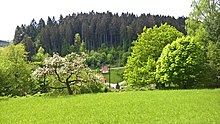Grinding mill (Bischbrunn)
|
Grinding mill
Community Bischbrunn
Coordinates: 49 ° 50 ′ 58 " N , 9 ° 29 ′ 34" E
|
|
|---|---|
| Height : | 281 m above sea level NHN |
| Residents : | 8 (23 Jan 2020) |
| Postal code : | 97852 |
| Area code : | 09394 |
|
The main building of the grinding mill
|
|
The grinding mill is a wasteland in the outer area in the district of Bischbrunner Forst of the municipality of Bischbrunn in the Lower Franconian district of Main-Spessart in Bavaria .
location

It is the uppermost mill in the Mühlental (Haslochbach and Schleifbach), consisting of a total of four permanent buildings. Sas Mühlenanwesen is located in the middle part of the Schleifbach , which flows from the northwest from the Spessarthöhe parallel to the A3 motorway into the valley and after the mill flows at right angles to the southwest past the Finstereck past the Zwieselmühle and flows into the Haslochbach .
The nearest towns are several kilometers away from the Schleifmühle. No tarred access roads - only gravel roads - lead into the remote valley to the former mill. The property has no connection to a public water or sewage supply, but has its own source and sewage treatment plant .
description
In 1694 it was first mentioned as a "Springmühle" when the Spessart was surveyed. In 1772 Johann Sator , the legendary forester of the Kurmainz and notorious for killing the well-known Spessart poacher, Johann Adam Hasenstab , had his son Johann Adam baptized. In 1812, when Napoleonic troops requisitioned the flour, the mill became increasingly impoverished. In 1891 the tenant of the Baumgartshof above the Schleifbach Valley , Johann Macarius Fries , took over the grinding mill. In 1911, master miller Emil Christ , son-in-law of Johann Macarius Fries, extended the mill buildings and modernized the grinder .
A chapel has stood next to the mill since 1929 , which was built for a successful birth after several pregnancies and is now designated as a monument with the number D-6-77-120-12 (see also | List of architectural monuments in Bischbrunn # Schleifmühle ). The builders were Emil Christ and Eugen Fries . The chapel is privately owned by the mill owners, but can be made available for services and celebrations on request.
In 1941 the mill burned down completely, but was immediately rebuilt. The inn was opened in 1970 and has also been offering guest houses since 1996. In 1974 the mill was given up, so that today agriculture and tourism still characterize the property. On January 1st, 2009 the hamlet came with the dissolution of the forest markings Bischbrunner Forst by incorporation into Bischbrunn.
Web links
- For the history of the mill , website of the owners
- Table 6: Mühlenstraße Haseltal. Start at the Schleifmühle , description board of the Spessart circular route Mühlenstraße Haseltal of the Archaeological Spessart Project on www.spessartprojekt.de
- Schleifmühle in the local database of the Bavarian State Library Online . Bavarian State Library
Individual evidence
- ↑ About us , website of the grinding mill; accessed on February 12, 2020
- ↑ Chronicle of the community in Bischbrunn on the community website www.bischbrunn.de ; accessed on February 12, 2020
- ↑ Ed .: Municipality of Bischbrunn-Oberndorf: Contributions to history - Bischbrunn / Oberndorf (Volume 1), Triltsch Publishing House, Würzburg 1992, ISBN 978-3-980-3239-0-1 . 238 pages
- ↑ a b c About us , website of the grinding mill; accessed on May 7, 2018
- ↑ Information board at the grinding mill


